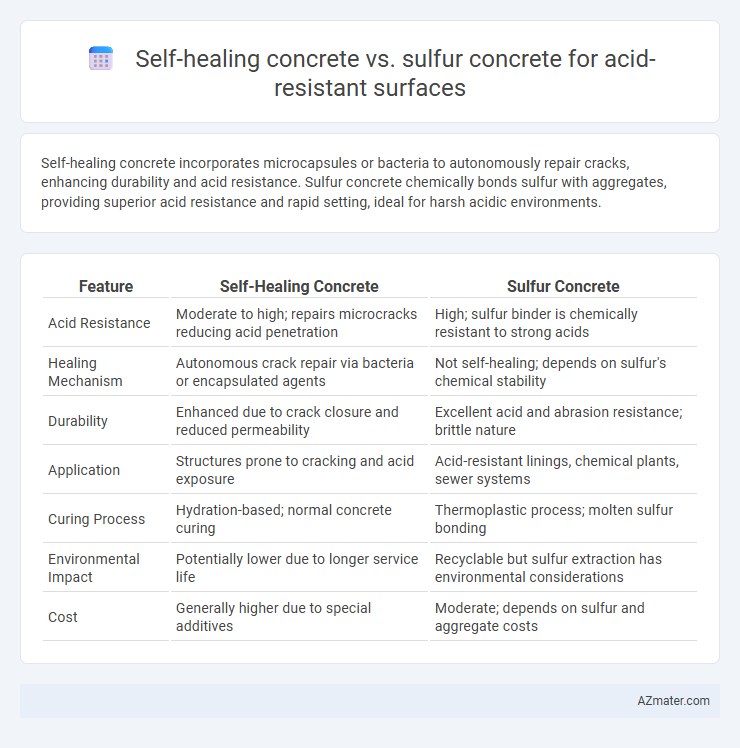Self-healing concrete incorporates microcapsules or bacteria to autonomously repair cracks, enhancing durability and acid resistance. Sulfur concrete chemically bonds sulfur with aggregates, providing superior acid resistance and rapid setting, ideal for harsh acidic environments.
Table of Comparison
| Feature | Self-Healing Concrete | Sulfur Concrete |
|---|---|---|
| Acid Resistance | Moderate to high; repairs microcracks reducing acid penetration | High; sulfur binder is chemically resistant to strong acids |
| Healing Mechanism | Autonomous crack repair via bacteria or encapsulated agents | Not self-healing; depends on sulfur's chemical stability |
| Durability | Enhanced due to crack closure and reduced permeability | Excellent acid and abrasion resistance; brittle nature |
| Application | Structures prone to cracking and acid exposure | Acid-resistant linings, chemical plants, sewer systems |
| Curing Process | Hydration-based; normal concrete curing | Thermoplastic process; molten sulfur bonding |
| Environmental Impact | Potentially lower due to longer service life | Recyclable but sulfur extraction has environmental considerations |
| Cost | Generally higher due to special additives | Moderate; depends on sulfur and aggregate costs |
Introduction to Acid-Resistant Surfaces
Acid-resistant surfaces are critical in industries dealing with corrosive chemicals, where durability and safety are paramount. Self-healing concrete utilizes embedded microcapsules or bacteria to repair cracks autonomously, enhancing longevity in acidic environments. Sulfur concrete, composed of molten sulfur binder and aggregate, offers exceptional chemical resistance, particularly against strong acids, making it a preferred choice for highly corrosive applications.
Overview of Self-Healing Concrete
Self-healing concrete incorporates microcapsules or bacteria that activate upon crack formation, releasing healing agents that seal cracks and restore structural integrity, offering superior durability in acid-exposed environments. Its ability to autonomously repair damage reduces maintenance costs and extends service life compared to sulfur concrete, which relies on sulfur's chemical resistance but lacks self-repair capabilities. The enhanced acid resistance and longevity of self-healing concrete make it a promising material for infrastructure exposed to aggressive chemical conditions.
Overview of Sulfur Concrete
Sulfur concrete is a polymer-based composite material known for exceptional acid resistance, making it ideal for industrial applications involving harsh chemical environments. It consists of molten sulfur acting as a binder combined with aggregates, providing high durability and rapid setting times compared to traditional cementitious materials. Its unique chemical inertness ensures minimal degradation when exposed to acidic substances, outperforming many conventional concrete types in corrosive conditions.
Chemical Resistance: Self-Healing vs Sulfur Concrete
Self-healing concrete exhibits enhanced chemical resistance by autonomously repairing micro-cracks, preventing acid ingress and prolonging structural integrity under acidic exposure. Sulfur concrete demonstrates superior acid resistance through its dense, non-porous matrix and inherent chemical inertness, effectively resisting sulfuric and hydrochloric acids. Comparing both, sulfur concrete provides immediate and robust acid resistance, while self-healing concrete offers long-term durability by combining chemical resistance with self-repair capabilities in acid-prone environments.
Durability in Acidic Environments
Self-healing concrete exhibits enhanced durability in acidic environments through its ability to autonomously repair microcracks, reducing acid ingress and structural degradation. Sulfur concrete offers strong resistance to acids due to its non-porous, chemically inert sulfur binder, which prevents acid attack and prolongs service life. Comparing the two, self-healing concrete provides long-term maintenance advantages, while sulfur concrete delivers immediate and robust acid resistance without the need for repair mechanisms.
Maintenance Requirements and Longevity
Self-healing concrete significantly reduces maintenance efforts by autonomously repairing micro-cracks caused by acid exposure, enhancing durability and extending service life in harsh environments. Sulfur concrete offers excellent initial acid resistance but requires regular monitoring and potential resurfacing due to its susceptibility to thermal degradation and brittleness over time. Combining innovative sealing mechanisms in self-healing concrete with the acid-resistant properties of sulfur concrete can optimize longevity and reduce long-term maintenance costs for industrial applications.
Installation and Curing Processes
Self-healing concrete employs encapsulated healing agents activated upon crack formation, requiring standard curing processes similar to conventional concrete, which can extend installation time due to monitoring needs. Sulfur concrete involves molten sulfur as a binder, necessitating elevated temperature handling during installation and rapid cooling for curing, allowing faster setting but demanding specialized equipment. The choice impacts project timelines and equipment costs, with self-healing concrete favoring ease of repair while sulfur concrete offers quicker acid-resistant surface readiness.
Environmental Impact and Sustainability
Self-healing concrete incorporates bacteria or encapsulated agents that autonomously repair cracks, reducing maintenance frequency and material waste, thereby lowering its environmental footprint. Sulfur concrete, made by blending elemental sulfur with aggregates, offers excellent acid resistance and recyclability but relies on sulfur, a byproduct of fossil fuel refining, which can raise sustainability concerns depending on source and processing. Evaluating environmental impact, self-healing concrete typically promotes longer lifespan and reduced repair cycles, enhancing sustainability compared to sulfur concrete, which benefits from recyclability but may involve higher initial carbon emissions linked to sulfur extraction and processing.
Cost Comparison and Economic Feasibility
Self-healing concrete, embedded with microcapsules or bacteria that repair cracks autonomously, generally incurs higher upfront costs due to advanced material technologies and specialized production processes, though it offers long-term savings by reducing maintenance and extending lifespan. Sulfur concrete, made from molten sulfur and aggregates, tends to have lower initial costs and faster setting times but may require more frequent repairs in highly acidic environments, potentially increasing lifecycle expenses. Economic feasibility analyses favor self-healing concrete for projects prioritizing durability and minimized repair frequency, while sulfur concrete remains attractive for budget-constrained applications with moderate acid exposure.
Best Applications for Each Concrete Type
Self-healing concrete excels in infrastructure exposed to minor cracks and chemical attacks, such as wastewater treatment plants and chemical storage tanks, by autonomously repairing microcracks and maintaining acid resistance. Sulfur concrete is better suited for environments requiring rapid setting and high sulfur content resistance, like industrial floors and acid-resistant coatings in sulfuric acid production facilities. Both materials offer distinct advantages based on environmental exposure, with self-healing concrete prioritizing longevity and sulfur concrete focusing on chemical inertness.

Infographic: Self-healing concrete vs Sulfur concrete for Acid-resistant surface
 azmater.com
azmater.com